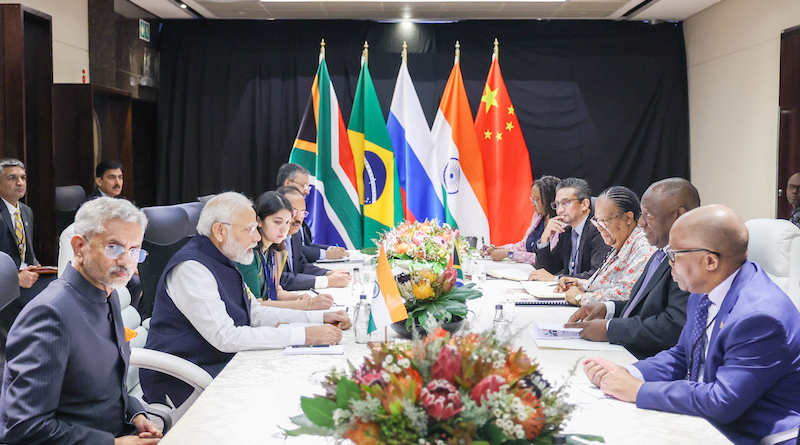BRICS Summit: Why India’s PM Narendra Modi Focused On Resilient And Inclusive Supply Chain – Analysis
There has been growing chatter on Prime Minister Narendra Modi’s assertion on India’s resilient and inclusive supply chain at the 15th BRICS summit, held at Johannesburg, leaving aside the major global issues, which are crippling world geo-politics and economic growth. The issues left with less focus in the summit were the Ukraine war, the US-China face off, the US dollar as a weapon for sanctions, traumatizing global energy balance and the widening gulf between global west and south.
The BRICS, which was born a platform for ameliorating the bickering among the member countries, raised eyebrows over Modi’s focus on resilient and inclusive supply chain, which reflects a silent challenge to China. Critics quipped it was an attempt to denigrate Chinese supremacy in the supply chain and pave the way for an era of an alternative supply chain. In 2021, India emerged as the second nation in the rank for Global Manufacturing Risk Index, surpassing the USA, according to Cushman & Wakefield.
Modi’s focus on supply chain could be construed as an extension of India’s leadership in 2nd IPEF (Indo-Pacific Economic Framework) for Prosperity Ministerial Meeting at Detroit in May 2023, where an agreement was signed by 14 member nations for supply chain resilience. Under the supply chain pillar, partner countries focussed to ensure supply chains more resilient, robust and well integrated through crisis mitigation of disruptions. This open ample opportunities for India to wield its manufacturing power for supply chain among the 14 nations.
Supply chain disruption dashed world economic growth. It declined to 3.2 percent in 2022, from 6 percent in 2021. It is expected to slip further to 1.3 percent in 2023, according to the IMF.
On the contrary, supply chain disruption, caused by zero COVID policy and overdependence on China, has become a boon to India. It evokes opportunities for India to emerge a noticeable destination for supply chain after China underwent deep deflation, owing to its zero COVID policy. This means that India can utilize the trends of de-coupling or de-risking of investment from China and lure foreign investors and boost domestic sentiment to give a new lease of life to Make in India, which was losing steam.
Nevertheless, India will face several challenges to become a competent destination for alternative to China for supply chain. The challenges are expected to be vied by newly industrialized nations in South East Asia, like Vietnam, Thailand, Malaysia, Singapore and Philippines.
India was ranked the 5th largest manufacturing country in the world, according to UNSD (United Nation Statistics Division). Its manufacturing output, valued at US$412 billion in 2018, accounted for 3.1 percent of Global Manufacturing Output. It edged out South Korea and the UK, who roiled with 3 percent and 1.8 percent, respectively.
Standford economist and Nobel laureate Michael Spence declared “India is the outstanding performer now, noting that the country remained the most preferred destination for investment”. Julie Gerdeman, the CEO of supply chain risk management platform Everstream, said “India has a large labour pool, a long history of manufacturing and government support for boosting industry and exports. Because of these, many are exploiting whether India is viable alternative to China”.
This is despite the fact that India is saddled by criticisms for its sagging investment facilities, crippled by red tape and poor infrastructures, to set up a factory. Its new policy Make in India failed to the expectation to achieve the industry target of 22 percent share in GDP in 2022, from 17 percent in 2014. Given these factors, India has been pushed to the back bench for investment in manufacturing, despite ranking 5th largest manufacturing nation in the world.
Paradoxically, countries like Vietnam, Thailand, Malaysia, Singapore and Philippines, who pose challenges to India for supply chain manufacturing, drew less foreign investment than India. Most of these nations attracted foreign direct investment less than half of India during the past three years. For example, in 2022, FDI flow in India amounted to US$49,355 million, as compared to US$17,909 million, US$10,034 million, US$16,940 million and US$21,968 in Vietnam, Thailand, Malaysia and Indonesia respectively, according to World Investment Report, 2023.
Vietnam has been hyped as an important destination for the supply chain. Throes of US firms shifting from China to Vietnam pose it as a tough competitor to India.
Nevertheless, India has several advantages to edge out Vietnam. Firstly, it has a larger domestic market and a larger pool of skilled workforce, including in IT operations. Secondly, it is far ahead in digitization than Vietnam. Lastly, political sovereignty of India is more stable, against Vietnam constantly facing the Chinese threat in the South China Sea.
Given the changing scenario of manufacturing in the world, where China is losing steam, giving a new lease of life to other emerging manufacturing nations, India’s sparking rise in the Global Manufacturing Risk Index can pose a big challenge to South East Asian countries.

